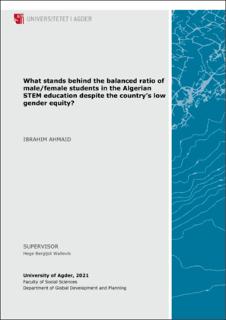| dc.contributor.author | AHMAID, IBRAHIM | |
| dc.date.accessioned | 2021-11-08T08:11:46Z | |
| dc.date.available | 2021-11-08T08:11:46Z | |
| dc.date.issued | 2021 | |
| dc.identifier.citation | Ahmaid, I. (2021) What stands behind the balanced ratio of male/female students in the Algerian STEM education despite the country’s low gender equity? (Master's thesis). University of Agder, Kristiansand. | en_US |
| dc.identifier.uri | https://hdl.handle.net/11250/2828260 | |
| dc.description | Master's thesis in Global Development and Planning (UT505) | en_US |
| dc.description.abstract | The study's main objective is to elucidate the reasons behind gender equality in the STEM education in the Algerian universities despite the lack of gender equity noticed in society. This study starts from Stoet and Geary’s findings in regard to the gender equality paradox in STEM, which considers that Algerian women are forced to choose to pursue STEM field studies in university in a look for better economic prospects. However, through a mixed qualitative and quantitative methodology that includes 51 surveys and five semi-structured interviews, the study shows that Algerian women take into consideration other elements when choosing a degree, such as their results in the Baccalaureate, the suitability of the skills acquired during their high school for their choice in university, and the prestige of their future major or university. We conclude that the Algerian education system has initiated a university orientation system that encourages continuity and pushes fresh university students to stick to fields that are closely similar to their high school specialization. While discussing the criticism Stoet and Geary’s theory of gender equality paradox has faced, this study looks into the causes of the gender gap in STEM education and the possible solutions. Four major perspectives on the issue of gender misrepresentation in STEM are identified. The first one focuses on individual abilities, such as reading and spatial skills and performance at school, the second one looks into the social dimensions influencing decision-making and behaviours both in STEM and in the general society, the third perspective studies the workplace environment, and finally, the fourth perspective examines how women’s self-image and internalized beliefs affect their career choices. | en_US |
| dc.language.iso | eng | en_US |
| dc.publisher | University of Agder | en_US |
| dc.rights | Attribution-NonCommercial-NoDerivatives 4.0 Internasjonal | * |
| dc.rights.uri | http://creativecommons.org/licenses/by-nc-nd/4.0/deed.no | * |
| dc.subject | UT505 | en_US |
| dc.title | What stands behind the balanced ratio of male/female students in the Algerian STEM education despite the country’s low gender equity? | en_US |
| dc.type | Master thesis | en_US |
| dc.rights.holder | © 2021 IBRAHIM AHMAID | en_US |
| dc.subject.nsi | VDP::Samfunnsvitenskap: 200::Sosiologi: 220 | en_US |
| dc.subject.nsi | VDP::Samfunnsvitenskap: 200::Kvinne- og kjønnsstudier: 370 | en_US |
| dc.source.articlenumber | 83 | en_US |

